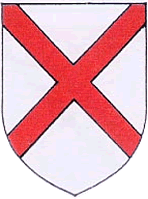 to Bios Page
to Bios Page to
Family Page
to
Family Page to
Peerage Page
to
Peerage Page to Home Page
to Home Page
Sir John NEVILLE of Chevet, Knight Born:
ABT 1471, Liversedge, Birstall, Yorkshire, England Father:
John
NEVILLE of
Liversedge (Sir) Mother: Maud RYTHER Married: Elizabeth BOSVILLE (dau. of William Bosvile of Chevet)
(wid. of Sir Thomas Tempest) BEF Aug 1509 2. Henry
NEVILLE of Chevet (Sir) 3. Richard NEVILLE 4. Anne NEVILLE 6. William NEVILLE 7.
Francis NEVILLE of
Barnby Don 8. Edith NEVILLE The details in this biography come from the
History of Parliament, a
biographical dictionary of Members of the House of Commons. Born by 1488, third son of Sir John
Neville of Liversedge,
by Maud, dau. of Sir Ralph Ryther of Rither, Yorks. Maud may have been a sister to the
Sir Ralph Ryther given here as
her father, HOP states that she was the daughter of Sir Ralph Rither of
Rither, Yorks. Married, by Aug 1509, Elizabeth,
dau. and coh. of William Bosvile of Chevet, wid. of Sir Thomas Tempest
of Bracewell, Yorks. (d. 1507), at least 4s. 4da. Kntd. 25 Sep 1513. Yeoman of the horse by 1509; keeper, Old park, Wakefield, Yorks. 1509,
Cotescue Park, lordship of Middleham, Yorks. 1532; warden, Selwood forest, Som.
1515; numerous other forestry offices; constable, Tintagel castle, Cornw. 1516;
sheriff, Yorks. 1518-19, 1523-4, 1527-8; receiver and surveyor, forfeited lands
of Edward Stafford, 3° D. Buckingham 1522, Holderness, Yorks. 1522, jt. 1527; commr.
subsidy Yorks. (W. Riding) 1523, 1524, offences against clothing statutes Yorks.
1533, tenths of spiritualities, Leics. 1535, for survey of monasteries, Leics.
1536, j.p. Yorks. (N. Riding) 1532, (W. Riding) 1538-d.; knight of the body by
1533; steward and feodary, duchy of Lancaster, honor of Leicester, 1534;
steward, forfeited lands of Lord Darcy 1538; gent. pens. 1540-d.2
John Neville was a courtier, soldier and administrator. He belonged to the
prolific and powerful northern family but as a younger son of a cadet branch his
early prospects cannot have been good. He presumably gained his footing in the
Household through his relatives in the royal service.
The first traces of Neville date from 1509: he attended the funeral of
Henry
VII and obtained the wardship of his own stepdaughter. His marriage with a
Yorkshire heiress, which had taken place by Aug 1509, established him in the
West Riding, where he came to occupy the position once enjoyed by her forbears:
to point his ascendancy he undertook the rebuilding of Chevet, which he was to
boast made him no man's debtor. His local progress was matched by his advance at
court. In 1513 he was in the army which besieged Tournai and on the city's fall
he was knighted. His skill in arms served him not only on the battlefield but
also at the lists, and in 1520 he was chosen to joust both at the
Field of the Cloth of Gold and at Gravelines. Three years later it was
put to a severer test against the Scots, and the second shrievalty which
followed shows that it had come through satisfactorily. This was an office which
Neville prized, but after he had held it for the third time in 1527-8 his
request for a fourth term was denied. Neville may have entered Parliament before 1529, the names of the Members of
the earlier Parliaments of the century being mostly lost, but the addition of a
proviso to the Act of 1523 (14 and 15 Hen. VIII, c.20) attainting the
Duke
of Buckingham which protected his receivership of the
Duke's forfeited Yorkshire
lands, does not of itself imply that he sat in the Parliament which passed that
measure. He was not one of the original Members of the next Parliament, but the
succession of his kinsman and namesake
John Neville as the 3rd Lord Latimer left vacant one
of the knighthoods for Yorkshire.
Latimer perhaps helped
Neville to fill it on 3
Feb 1533, but what probably settled the matter was his nomination by
Cromwell
and the suitability of his residence in the West Riding,
Latimer being a man
from the North Riding and the other knight
Sir Marmaduke Constable from the
East. Nothing has come to light ABT Neville's part in the work of this
Parliament. Presumably he served for Yorkshire again in the following one, that
of 1536, when the King asked for the re-election of the previous Members. When the
Pilgrimage of Grace began,
Neville was with
George Talbot, 4° E.
Shrewsbury surveying monastic houses in Leicestershire. Three of his sons and
two of his sons-in-law helped to restore order but his sister, who was married
to Christopher Stapleton of Wighill, openly supported the insurgents.
Neville
assured Cromwell of his own loyalty and the minister approved his selection as a
juror to try the rebels. His friendship with
Cromwell did not yield him the
monastic property that he coveted but equally the catastrophe of 1540 did not
harm him. Neville's undoing was his failure in the next year to report a
conspiracy in the West Riding: in Apr 1541 he was arrested, committed to the
Tower and arraigned for treason. The Privy Council decided against his execution
at the same time as the Countess of Salisbury's, which the conspiracy had
precipated, and on 3 Jun ordered his removal to York, where he was put to death
twelve days later. The French Ambassador described Neville as ‘a man well known
at the court but of mediocre ability and wit’. His wife and heir sued out
pardons in the month of his death, but it was not until 1552 that his children
were restored in blood by a private Act (5 and 6 Edw. VI, no.29). His
descendants continued to live at Chevet until the 18th century when the family
died out.
 to Bios Page
to Bios Page |
 to
Family Page to
Family Page |
 to
Peerage Page to
Peerage Page |
 to Home Page
to Home Page |